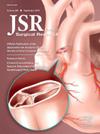Association of Socioeconomic Disadvantage With Postoperative Length of Stay
IF 1.8
3区 医学
Q2 SURGERY
引用次数: 0
Abstract
Introduction
Socioeconomic factors significantly influence postoperative recovery, which is a crucial consideration in reducing disparities within enhanced recovery after surgery (ERAS) protocols. The Area Deprivation Index (ADI) serves as a validated measure of neighborhood-level socioeconomic disadvantage; however, its association on postoperative length of stay (LOS) remains underexplored.
Methods
This retrospective cohort study analyzed data from October 2016 to May 2022, examining the association between ADI and postoperative LOS among ERAS patients undergoing elective surgery. Addresses were geocoded and assigned ADI scores, categorizing patients into low, medium, and high ADI levels. Logistic regression models, adjusting for covariates such as insurance status and comorbidities, were used to assess the relationship between ADI and extended LOS, defined as above the 75th percentile.
Results
The study included 11,640 patients with a median age of 56. Patients from high ADI neighborhoods had a significantly higher likelihood of extended LOS compared to those from low ADI neighborhoods (odds ratio 1.22; 95% confidence interval 1.10-1.36; P < 0.001), even after adjusting for demographic and clinical factors.
Conclusions
Higher socioeconomic disadvantage, as measured by ADI, is associated with prolonged postoperative hospital stays. These findings highlight the need for targeted interventions to mitigate disparities in surgical outcomes and enhance equity in ERAS protocols.
社会经济劣势与术后住院时间的关系
社会经济因素显著影响术后恢复,这是减少手术后增强恢复(ERAS)方案差异的关键考虑因素。区域剥夺指数(ADI)是衡量社区社会经济劣势的有效指标;然而,其与术后住院时间(LOS)的关系仍未得到充分探讨。方法本回顾性队列研究分析2016年10月至2022年5月的数据,研究选择性手术ERAS患者ADI与术后LOS之间的关系。对地址进行地理编码并分配ADI分数,将患者分为低、中、高ADI水平。采用Logistic回归模型,调整保险状况和合并症等协变量,评估ADI与延长LOS(定义为超过75百分位)之间的关系。结果该研究纳入11640例患者,中位年龄为56岁。与来自低ADI社区的患者相比,来自高ADI社区的患者延长LOS的可能性显著更高(优势比1.22;95%置信区间1.10-1.36;P & lt;0.001),即使在调整了人口统计学和临床因素之后。结论较高的社会经济劣势,如ADI测量,与术后住院时间延长有关。这些发现强调了有针对性的干预措施的必要性,以减轻手术结果的差异,提高ERAS协议的公平性。
本文章由计算机程序翻译,如有差异,请以英文原文为准。
求助全文
约1分钟内获得全文
求助全文
来源期刊
CiteScore
3.90
自引率
4.50%
发文量
627
审稿时长
138 days
期刊介绍:
The Journal of Surgical Research: Clinical and Laboratory Investigation publishes original articles concerned with clinical and laboratory investigations relevant to surgical practice and teaching. The journal emphasizes reports of clinical investigations or fundamental research bearing directly on surgical management that will be of general interest to a broad range of surgeons and surgical researchers. The articles presented need not have been the products of surgeons or of surgical laboratories.
The Journal of Surgical Research also features review articles and special articles relating to educational, research, or social issues of interest to the academic surgical community.

 求助内容:
求助内容: 应助结果提醒方式:
应助结果提醒方式:


